Computational Design Thinking II
- Location: Bogota, Colombia
- Year: 2021
- Work Type: Student
- Institute: Universidad de Los Andes, Colombia
- Status: Conceptual
- Team Members: Taught with Daniela Atencio & Alex Alcalá. TA: Samuel Mujica.
- Instructor: Carlos Navarro (M.DesR SCI-Arc)
“Pensamiento Computacional II” -i.e., Computational Thinking II- is a course-based research that introduces fundamental concepts and techniques related to computational design, focusing on time-based processes of manipulation and representation to augment material form. It comprises a series of methodologies to diverge the application of digital tools from traditional visualization and fabrication, and to vindicate their instrumentality in intelligent design processes of digital materiality and its latent physicalization, as a means to advance the architectural discourse into the Post-Digital era or, as coined by Mario Carpo, into the “Second Digital Turn”.
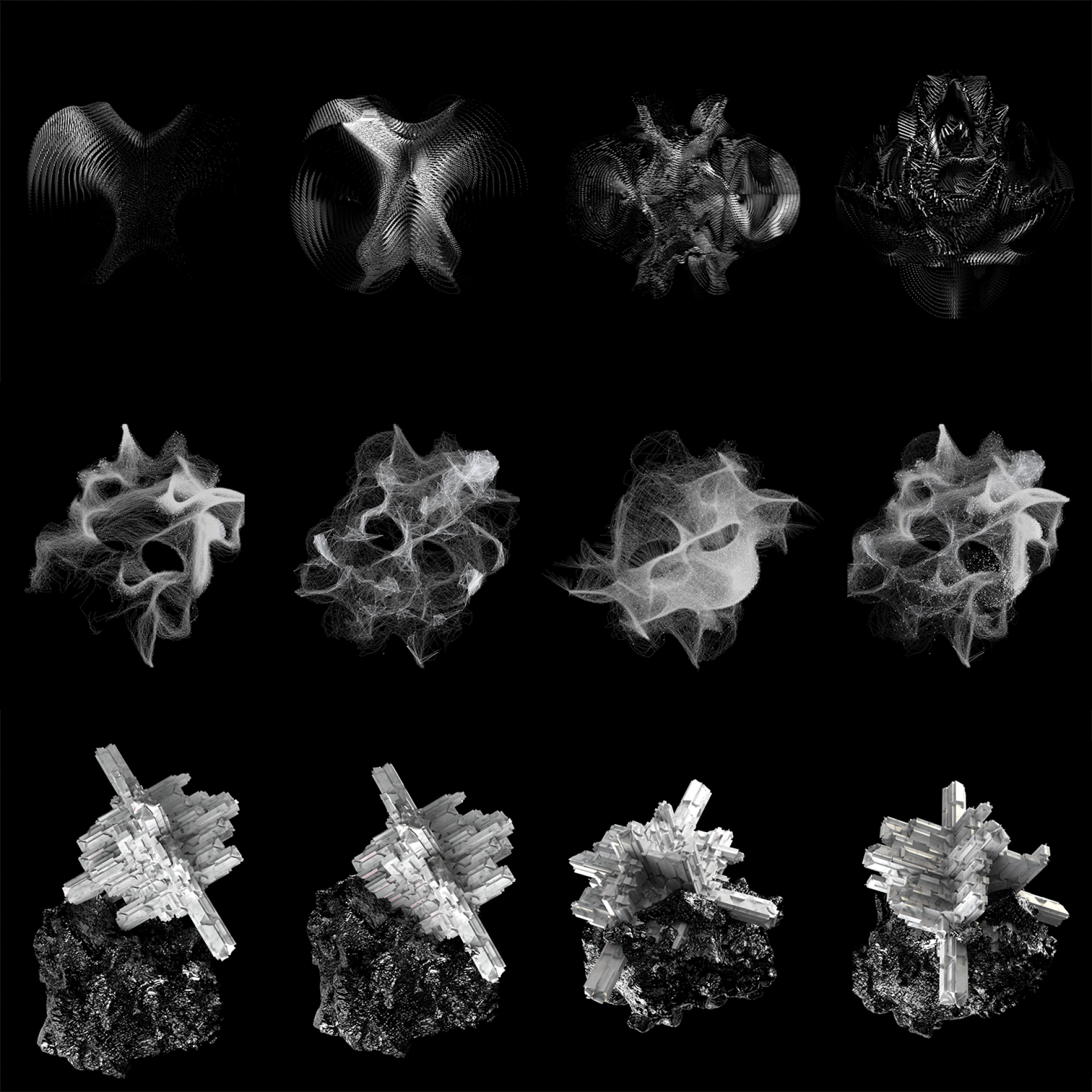 The applied methodologies operate on the conceptual frameworks of intelligence in computable matter, digital materiality manipulation, computational power and ornamentation, and material augmentation and simulation. Frameworks are utilized reciprocally, but not hierarchically, as discrete building blocks to construct unpredictable but relatable outcomes, revolving on the following concerns: To what degree the weight of intelligent generative algorithms or time-based simulations will entice more similar or distinct formal and material expressions?; To what extent the capacity of the applied computational processes will inherently reflect or indulge in a discreet logic of fabrication, to the point of advancing the concept of ornamentation and suggest a new found style – new Discretism, Computational Brutalism, or a Hyper-Ornament?; What are the roles and overlaps between representation and simulation in the current Post-Digital era, and what agency do they have with regards to a latent physicalization?
The applied methodologies operate on the conceptual frameworks of intelligence in computable matter, digital materiality manipulation, computational power and ornamentation, and material augmentation and simulation. Frameworks are utilized reciprocally, but not hierarchically, as discrete building blocks to construct unpredictable but relatable outcomes, revolving on the following concerns: To what degree the weight of intelligent generative algorithms or time-based simulations will entice more similar or distinct formal and material expressions?; To what extent the capacity of the applied computational processes will inherently reflect or indulge in a discreet logic of fabrication, to the point of advancing the concept of ornamentation and suggest a new found style – new Discretism, Computational Brutalism, or a Hyper-Ornament?; What are the roles and overlaps between representation and simulation in the current Post-Digital era, and what agency do they have with regards to a latent physicalization?
 The resulting outcomes of the researched frameworks allowed to structure a catalogue of four methodologies grouped by their specific software procedural approach, and capacity to simulate or represent the ultimate logic of a New Discretism or a Hyper- Ornament in digital materiality studies. The methods are autonomous but are introduced along the course with an order based on software ease of use and familiarity to undergraduate student. Thus, methods are called “Procedures” and are subsequently studied as follows: Generative Simulations, Synthetic Simulations, Phygital Simulations, Augmented Simulations.
The resulting outcomes of the researched frameworks allowed to structure a catalogue of four methodologies grouped by their specific software procedural approach, and capacity to simulate or represent the ultimate logic of a New Discretism or a Hyper- Ornament in digital materiality studies. The methods are autonomous but are introduced along the course with an order based on software ease of use and familiarity to undergraduate student. Thus, methods are called “Procedures” and are subsequently studied as follows: Generative Simulations, Synthetic Simulations, Phygital Simulations, Augmented Simulations.
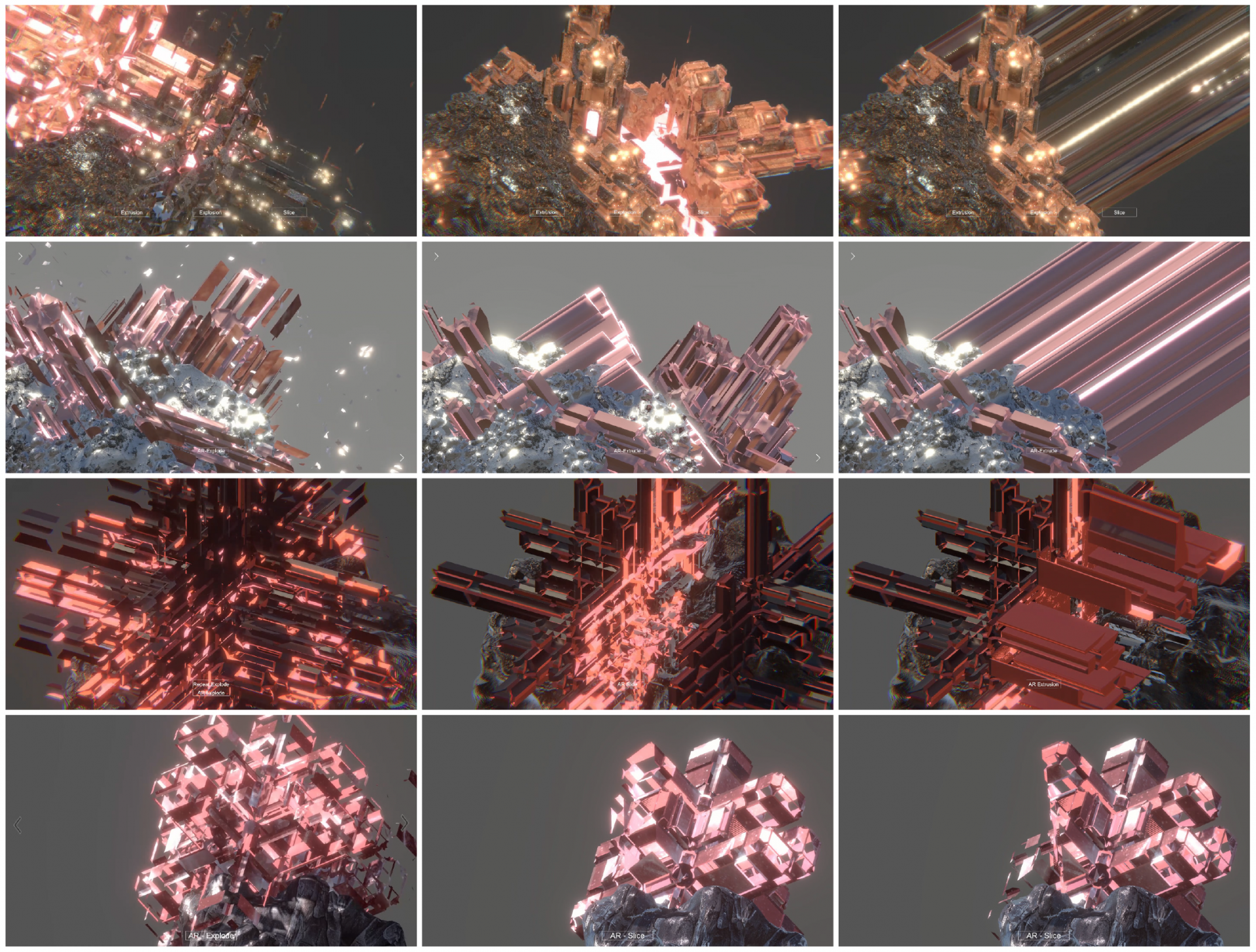 “Augmented Simulations” speculates on latent material intelligences of hyper-discretized procedurally generated assemblies by further manipulating and augmenting them through C# scripted behaviors and Alembic animator controllers to be deployed as iOS AR apps.
Made with Unity, AR Foundation, and Houdini. Featured Students:
1. Luisa Piedrahita, Isabel Restrepo, Miranda Uribe
2. Camila Gamboa, María José González, Valeria Hernández
3. María Alejandra Cristancho, Diego Alejandro Garzón, Juan David Salazar
4. Juan Nicolás Bogotá, Angela Bohorquez, Ezequiel Leibovich
“Augmented Simulations” speculates on latent material intelligences of hyper-discretized procedurally generated assemblies by further manipulating and augmenting them through C# scripted behaviors and Alembic animator controllers to be deployed as iOS AR apps.
Made with Unity, AR Foundation, and Houdini. Featured Students:
1. Luisa Piedrahita, Isabel Restrepo, Miranda Uribe
2. Camila Gamboa, María José González, Valeria Hernández
3. María Alejandra Cristancho, Diego Alejandro Garzón, Juan David Salazar
4. Juan Nicolás Bogotá, Angela Bohorquez, Ezequiel Leibovich
 Luisa Piedrahita, Isabel Restrepo, Miranda Uribe
Luisa Piedrahita, Isabel Restrepo, Miranda Uribe
 María Alejandra Cristancho, Diego Alejandro Garzón, Juan David Salazar
María Alejandra Cristancho, Diego Alejandro Garzón, Juan David Salazar
 “Phygital Simulations” operates within digitally simulated/physicalized hybrids. Virtual joinery of procedurally achievable hyper-ornamented tectonic and landscape assemblies is studied through hyper-realistic representation of feasible digital fabrication.
Made with Houdini, Maya, and Arnold. Featured Students:
1. Luisa Piedrahita, Isabel Restrepo, Miranda Uribe
2. María Alejandra Cristancho, Diego Alejandro Garzón, Juan David Salazar
3. Camila Gamboa, María José González, Valeria Hernández
4. Juan Nicolás Bogotá, Angela Bohorquez, Ezequiel Leibovich
5. Daniel Barrera, Lucas Bernal, Santiago Cabrera
“Phygital Simulations” operates within digitally simulated/physicalized hybrids. Virtual joinery of procedurally achievable hyper-ornamented tectonic and landscape assemblies is studied through hyper-realistic representation of feasible digital fabrication.
Made with Houdini, Maya, and Arnold. Featured Students:
1. Luisa Piedrahita, Isabel Restrepo, Miranda Uribe
2. María Alejandra Cristancho, Diego Alejandro Garzón, Juan David Salazar
3. Camila Gamboa, María José González, Valeria Hernández
4. Juan Nicolás Bogotá, Angela Bohorquez, Ezequiel Leibovich
5. Daniel Barrera, Lucas Bernal, Santiago Cabrera
 María Alejandra Cristancho, Diego Alejandro Garzón, Juan David Salazar
María Alejandra Cristancho, Diego Alejandro Garzón, Juan David Salazar
 Luisa Piedrahita, Isabel Restrepo, Miranda Uribe
Luisa Piedrahita, Isabel Restrepo, Miranda Uribe
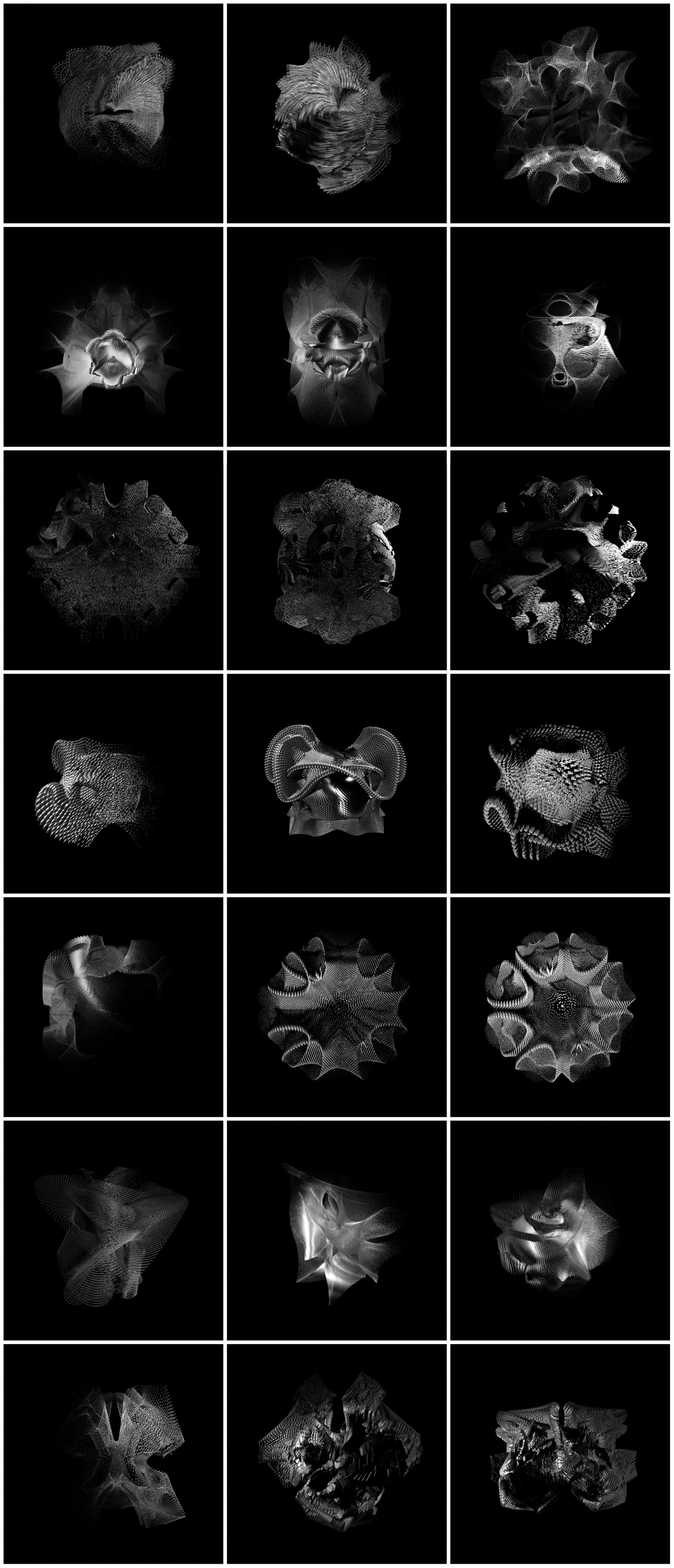 “Synthetic Simulations” investigates on time/duration-based design strategies for form finding aided by real-time representation. Alienating the influence of gravity and wind using Maya physics, as well as controlled force fields through personalized geometry extrapolation.
Made with Maya and Arnold. Featured Students:
1. Luisa Piedrahita, Isabel Restrepo, Miranda Uribe
2. Camila Gamboa, María José González, Valeria Hernández
3. Daniel Barrera, Lucas Bernal, Santiago Cabrera
4. María Alejandra Cristancho, Diego Alejandro Garzón, Juan David Salazar
5. Andrés Anzola, Manuela Gómez, Lorenzo Graham
6. Juan Pablo Corredor, Nicolás Dura?n, Mari?a Paula Tarazona
7. José Luis Baquero, José Alejandro Diaz, María Gabriela Gómez
“Synthetic Simulations” investigates on time/duration-based design strategies for form finding aided by real-time representation. Alienating the influence of gravity and wind using Maya physics, as well as controlled force fields through personalized geometry extrapolation.
Made with Maya and Arnold. Featured Students:
1. Luisa Piedrahita, Isabel Restrepo, Miranda Uribe
2. Camila Gamboa, María José González, Valeria Hernández
3. Daniel Barrera, Lucas Bernal, Santiago Cabrera
4. María Alejandra Cristancho, Diego Alejandro Garzón, Juan David Salazar
5. Andrés Anzola, Manuela Gómez, Lorenzo Graham
6. Juan Pablo Corredor, Nicolás Dura?n, Mari?a Paula Tarazona
7. José Luis Baquero, José Alejandro Diaz, María Gabriela Gómez
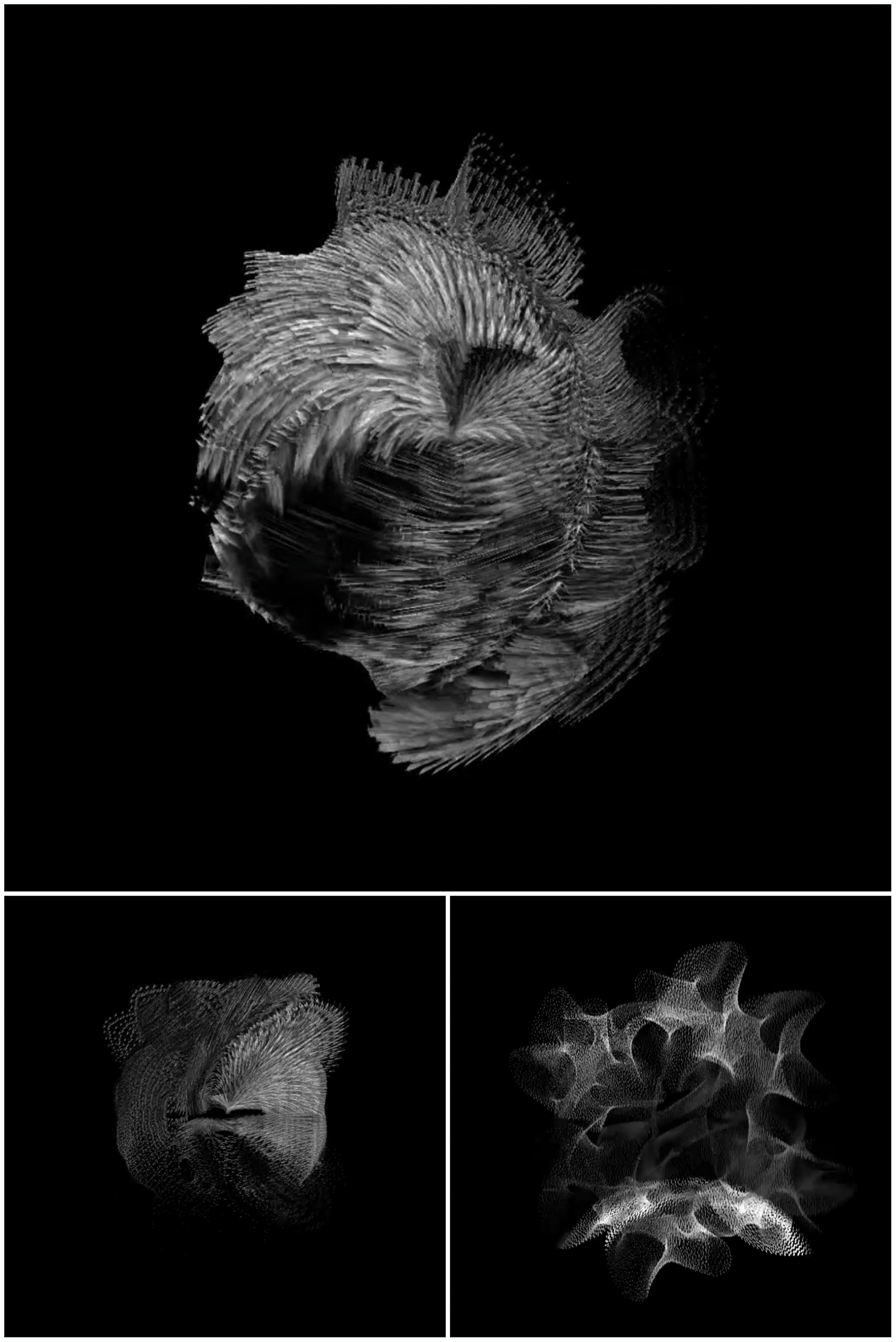 Luisa Piedrahita, Isabel Restrepo, Miranda Uribe
Luisa Piedrahita, Isabel Restrepo, Miranda Uribe
 José Luis Baquero, José Alejandro Diaz, María Gabriela Gómez
José Luis Baquero, José Alejandro Diaz, María Gabriela Gómez
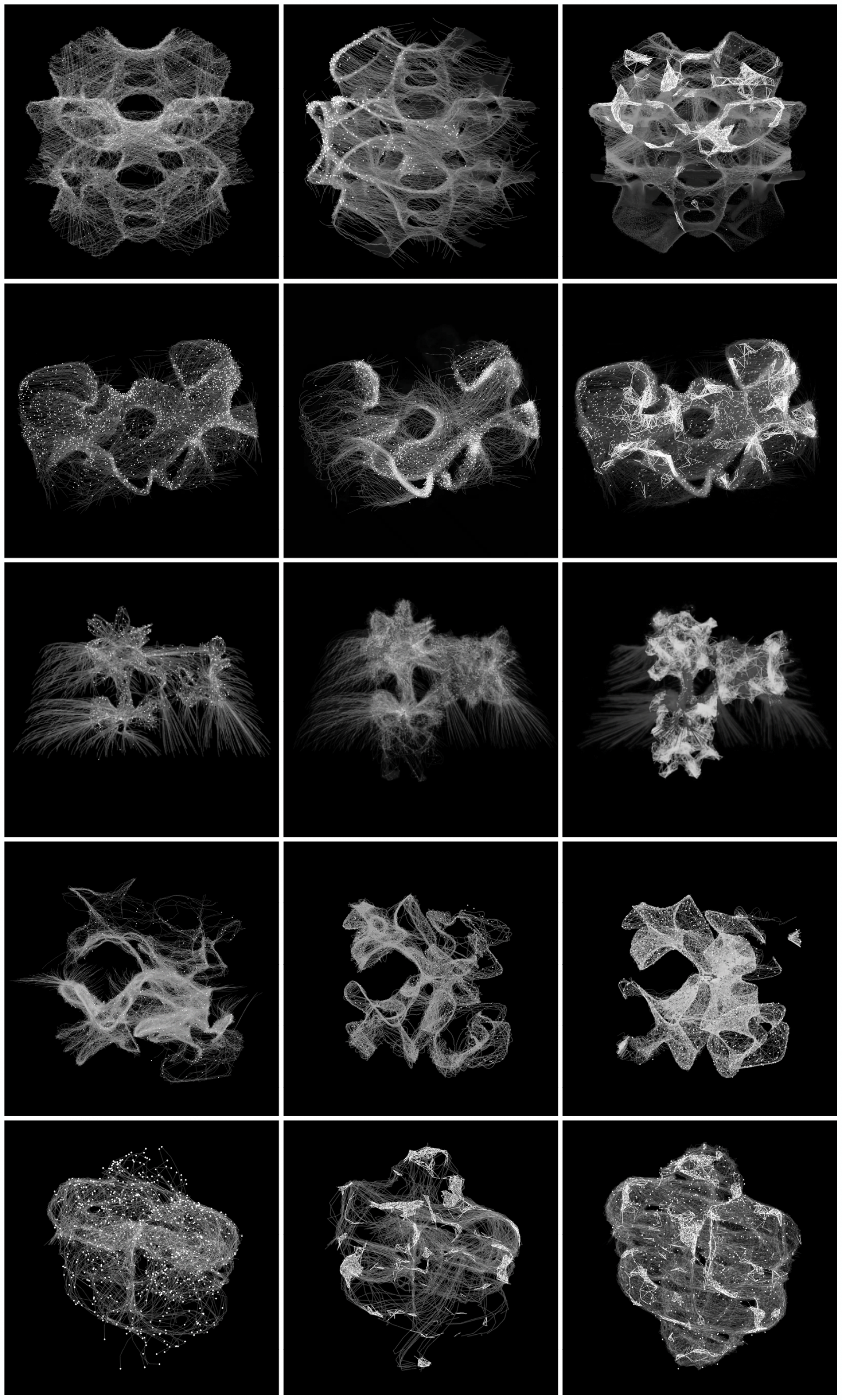 “Generative Simulations” encompasses multi-agent behaviors on SubD topologies and real-time dynamic representation. Python-based behavioral simulations are studied on the basis of Superabundance, including, Swarming, Noise, Attraction/Repulsion, Stigmergy, and others.
Made with Rhino 7 and Grasshopper. Featured Students:
1. María Alejandra Cristancho, Diego Alejandro Garzón, Juan David Salazar
2. Camila Gamboa, María José González, Valeria Hernández
2. Juan Pablo Corredor, Nicolás Dura?n, Mari?a Paula Tarazona
4. Luisa Piedrahita, Isabel Restrepo, Miranda Uribe
5. Andrés Anzola, Manuela Gómez, Lorenzo Graham
“Generative Simulations” encompasses multi-agent behaviors on SubD topologies and real-time dynamic representation. Python-based behavioral simulations are studied on the basis of Superabundance, including, Swarming, Noise, Attraction/Repulsion, Stigmergy, and others.
Made with Rhino 7 and Grasshopper. Featured Students:
1. María Alejandra Cristancho, Diego Alejandro Garzón, Juan David Salazar
2. Camila Gamboa, María José González, Valeria Hernández
2. Juan Pablo Corredor, Nicolás Dura?n, Mari?a Paula Tarazona
4. Luisa Piedrahita, Isabel Restrepo, Miranda Uribe
5. Andrés Anzola, Manuela Gómez, Lorenzo Graham
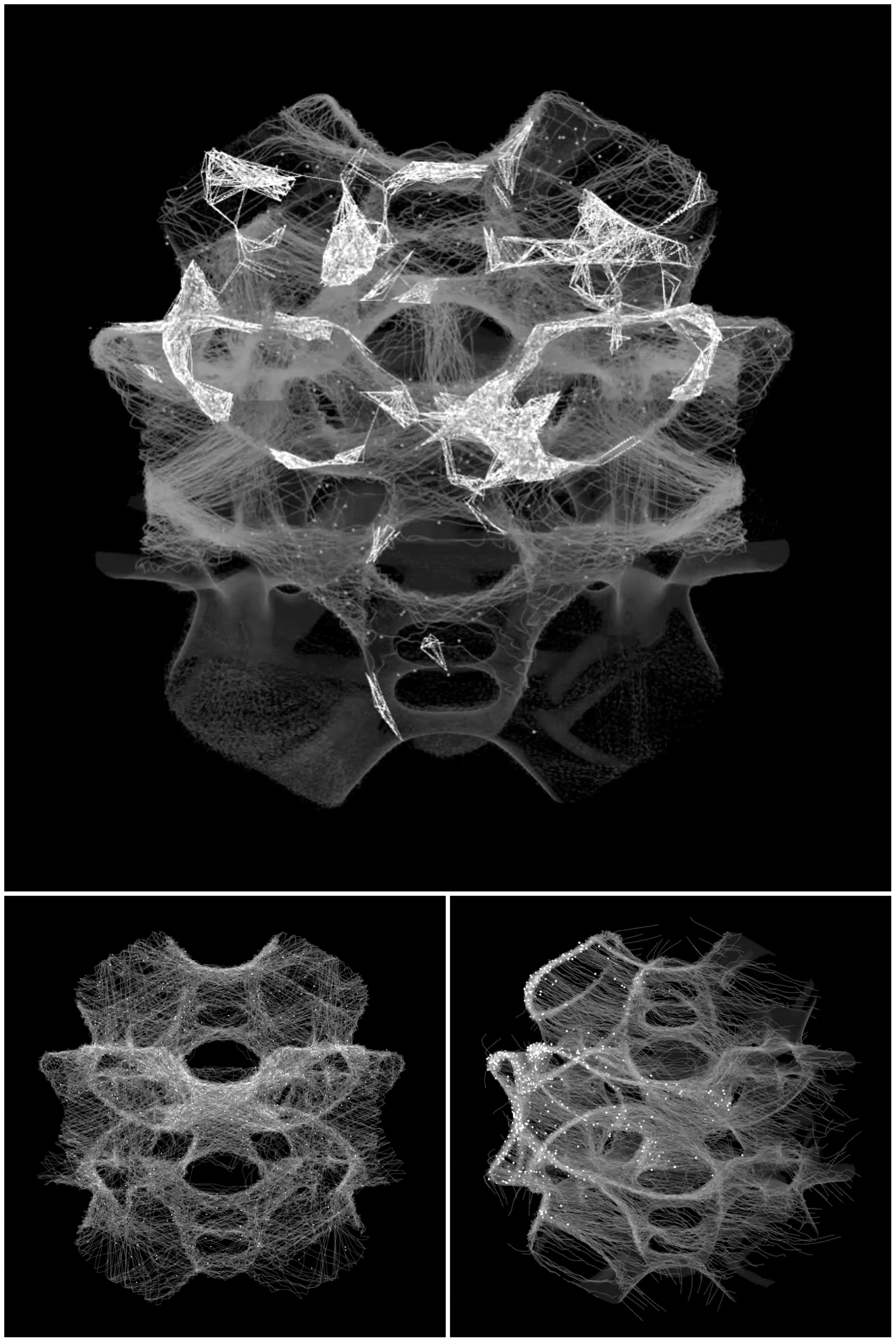 María Alejandra Cristancho, Diego Alejandro Garzón, Juan David Salazar
María Alejandra Cristancho, Diego Alejandro Garzón, Juan David Salazar
 Camila Gamboa, María José González, Valeria Hernández
Camila Gamboa, María José González, Valeria Hernández